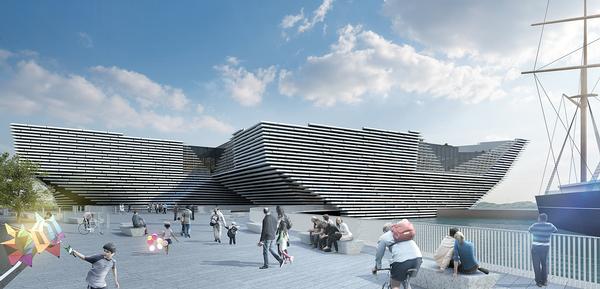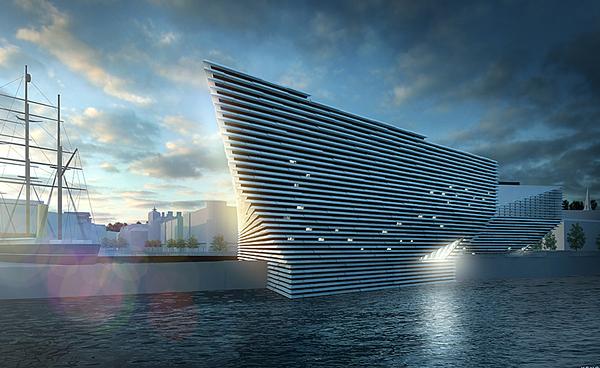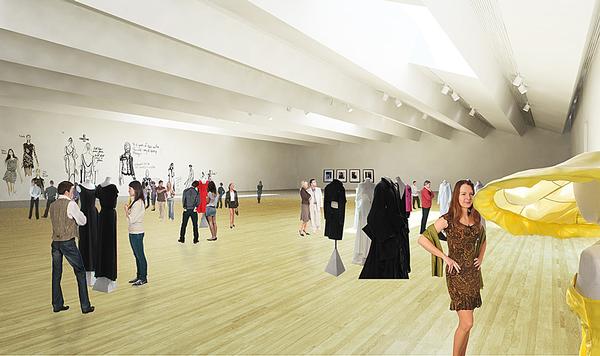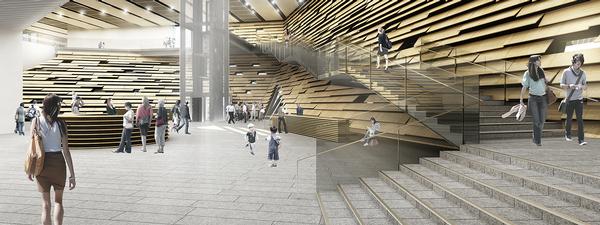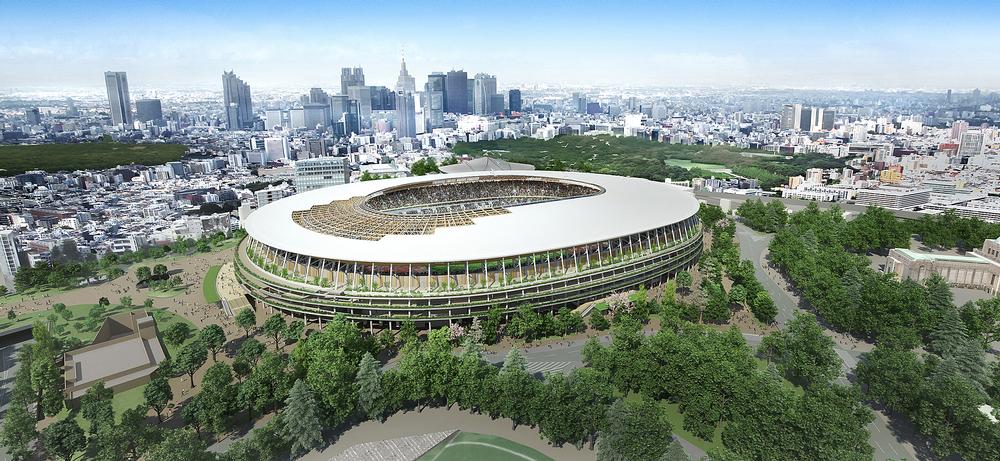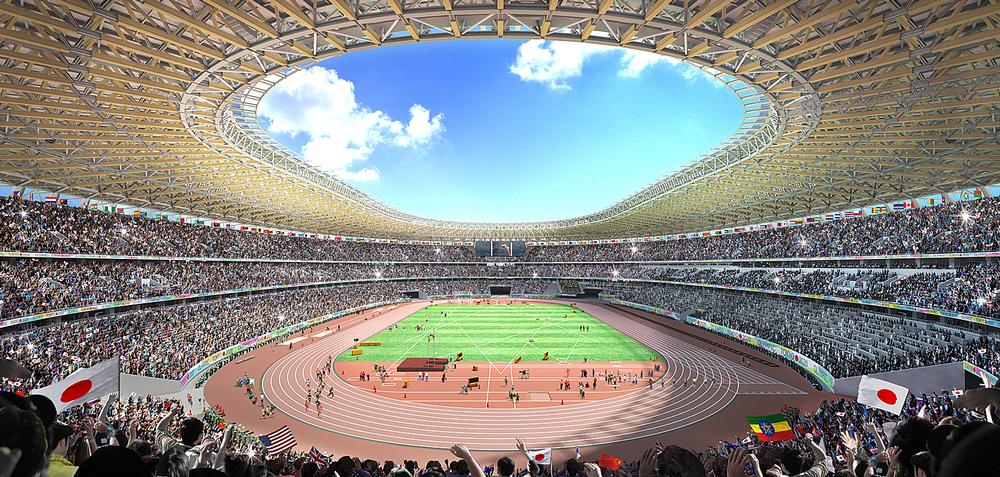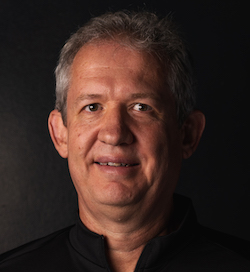features
Kengo Kuma: The architect discusses the Tokyo Olympic Stadium
The Tokyo Olympic Stadium architect meets Kim Megson to discuss the controversial project, as well as his other high profile commissions
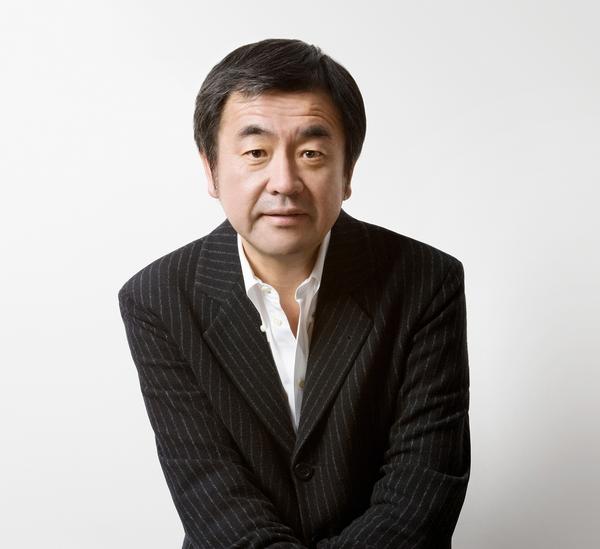
I meet Kengo Kuma at a canal-side café in Venice, where he is staying in the city to attend Alejandro Aravena’s Architecture Biennale. As we’re talking, he is spotted by a group of young architecture students from Japan. They wait patiently while we finish our interview so they can meet him and snap a selfie. Later, still starstruck, they tell me they came to the Biennale with a wishlist of architects to meet. Kuma was firmly at the top.
The architect is known and celebrated around the world for the elegance and simplicity of his work and his use of natural materials. His early projects set out to reinterpret traditional Japanese architecture for the 21st century, while his later designs – from stadiums and spas to houses and hotels – have become known for their lightness of touch following his self-declared ambition “to build with humbleness.”
This philosophy can be seen in Kuma’s best known buildings, including the white latticed Suntory Museum of Art in Tokyo, Japan; the timber Ginzan Onsen Fujiya in Yamagata, Japan; and the criss-crossing China Academy of Art in Hangzhou, China, which was completed last year.
Over the past year Kengo Kuma and Associates – the practice Kuma founded 26 years ago – have begun to channel their resources into bidding for a series of public museum projects. Following several competition wins, their portfolio of future museums now includes the Hans Christian Andersen Museum in Odense, Denmark; the Museum of Indigenous Knowledge in Manilla, the Philippines; and the Victoria & Albert Museum’s offshoot in Dundee, UK.
“The role of architects in the 21st century is to create a link between people and art,” Kuma tells me. “We should be the communicators between those two things. We have a responsibility to society not to allow isolation.
“In the last century, museums became separated from the culture around them. Now the best new ones are reconnecting with local life. I think they should be part of their street and neighbourhood surroundings, so with each new museum design I do I want to pick up an experience of the place.
“I don’t want these buildings to be a reflection of me. Some architects try to push their ideas onto a museum, whereas I try to dig into the spirit of the location and find its essence.”
With demand for his services high, life seems good for Kuma and his studio. However, one controversy has emerged which threatens to overshadow all these achievements.
The Tokyo Olympic Stadium saga
The Japanese government’s decision to rebuild the country’s National Stadium for the 2020 Tokyo Olympics has led to one of the most protracted and public sagas in the history of leisure architecture.
Zaha Hadid Architects (ZHA) won the initial competition for the design with Japanese studio Nikken Sekkei, but their design was eventually scrapped by Prime Minister Shinzo Abe, who said the cost had “ballooned too much” after almost doubling to US$2bn (€1.79bn, £1.52bn).
A succession of skirmishes followed, with ZHA issuing a robust defence of their design, blaming the cost increases on Japan's overheated construction market and the tendering process for the building, in which contractors were appointed before they submitted cost estimates.
The Japanese government ignored ZHA’s protests and organised a second competition, which Kuma’s studio won ahead of a design proposed by fellow Japanese architect Toyo Ito. ZHA then accused Kuma’s design of sharing “remarkable similarities with our original detailed stadium layout and our seating bowl [configuration].”
Kuma has always firmly denied the allegation, but the story has overshadowed his vision for the stadium. Throughout our conversation he is happy to talk about the project and explain the situation from his point of view.
“The communication between Zaha, the Japanese partners and the client was very bad,” he says. “I think it’s a problem in Japan. For foreign architects to work there is not easy because the system is totally different and a language barrier exists between the Japanese and foreigners. Zaha was very frustrated with that kind of miscommunication. I understand that difficulty, of course, but I was not happy to hear her claims about our scheme. It is totally opposite from Zaha’s design.”
Kuma concedes that there are shared elements, but claims such similarities are unavoidable given the nature of the scheme and building type.
“The site is very limited and the track has to be an Olympic size, so that determines a lot of things,” he explains, calmly. ”The escape evacuation points and the position of the stairs for example. This is unavoidable. But the design is totally opposite.” [For ZHA director Patrik Schumacher’s response, see p46.]
Despite the media attention and scrutiny, Kuma talks with great excitement about the stadium; the sort of project he says he’s been waiting his whole life to do. Once the government re-opened the competition, his studio dropped most of their other projects to concentrate on their submission “because the brief was to create a symbol for a new period for Japan.”
For Kuma, building such a venue for the Olympics has a personal resonance.
“We had our first Olympics in Japan in 1964, and those Games were very important for me,” he says. “It was a year of economic expansion in Japan. Really we hit a peak. Everything was going well and the architect Kenzo Tange perfectly symbolised that period by building a beautiful gymnasium [the Yoyogi National Gymnasium]. He was my hero. I was so impressed by that building, even at the age of 10, and it was after visiting it that I immediately decided to become an architect.”
Now given the opportunity to leave his own mark, Kuma wants his stadium, and the 2020 Games more broadly, to symbolise today’s Japan; a country “whose culture and direction is totally opposite to what went before” due to a slowing down of both economic growth and the pace of life.
“This new direction can be called the age of maturity,” he says. “People are finding a new, slower kind of lifestyle. But slowdown is not bad. Slowdown is creating new types of culture, new types of lifestyle. Actually, when you look at Japanese history, it is not a history of expansion. We’re basically very slow and very quiet, and I’m happy to see us go back to that time of quietness.
“For the stadium, I have used a lot of wood because I think it’s an appropriate material to symbolise this change.”
Indeed, the Olympic Stadium will feature an almost unprecedented amount of wood for a major sporting venue – from the steel and wood structure to the wooden façade and the trees that will be placed around the perimeter.
Kuma says the design captures the spirit of Japan by evoking the country’s traditional timber structures and wooden cities: “We once lived together and aged together with wood. I want to go back to that kind of natural circulation with my work.”
Connecting with nature
At its best, Kuma believes his built work creates this type of a strong connection with nature.
“Before me, especially in Japan, architects were working with concrete and steel,” he says. “But I’ve always tried to build with natural materials. In that sense I revolutionised the way materials are used, because now the young generation have all started to use wood for their small projects.
“If you open a Japanese magazine, you can see the change. Before me the architecture featured was quite grey. After me, it has tended to be the colour of wood. The tone is very different.”
As evidenced by the excitable students waiting for a photo, Kuma continues to inspire the next generation of Japanese architects. He enjoys mentoring and teaches at several Tokyo universities. So what message does he want to pass on to the future creators of our built environments?
“Developers often try to make short-term profit, but architects should always think of history and creating long-term benefits for people,” he says. “The problem of our period is the developers have huge money and influence. Governments are getting very weak and are letting these short-sighted people design cities by themselves.”
He thinks carefully before continuing.
“I think the winner in a project should be the building and the environment. Architects should never be the winner. We should respect the places where we work and respect the people who live there. That’s our philosophy, simply put.”
Kengo Kuma’s museums In his own words
The architect reveals the inspirations behind three of his most exciting museum designs
The Museum of Indigenous Knowledge, Manilla
The 97,000sq ft museum will cover 4,000 years of history, enabling visitors to experience the cultural and religious heritage of the Philippines’ indigenous peoples, starting from the Neolithic age. Kuma has created a jungle-inspired building seemingly located inside an enormous cave. Visitors will walk from the street through a soaring rock arch covered in tropical plants and into a large void. Inside, they’ll continue through a wild environment of jungle, streams, ravines, ponds and waterfalls to reach a central atrium, replicating the mountains and valleys where local people sought refuge following the arrival of Spanish colonisers.
The location of the museum is in an industrial park with a big factory there. The thought came to us that in this kind of industrial environment we should create nature ourselves.
The client told me about the value of the very first cultures of the Philippines. I was so impressed because I didn’t know that kind of really strong culture existed there. I thought the Philippines was a beautiful country, with beautiful nature, but the history was not all that interesting. On the contrary, I’ve discovered that its history is very long and very rich. I want to symbolise that strength through a design that is very much integrated with the beauty of nature.
In Manilla, the new buildings are mainly shopping centres and that kind of thing. I want to create a strong cultural core for the city.
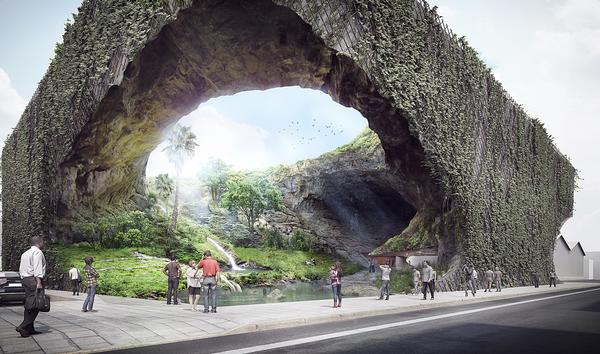
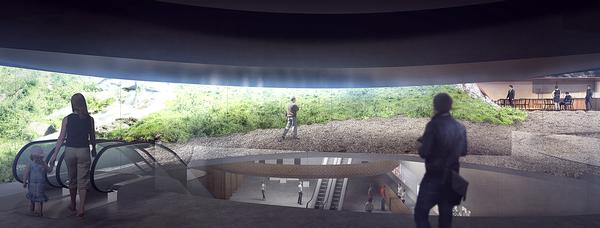
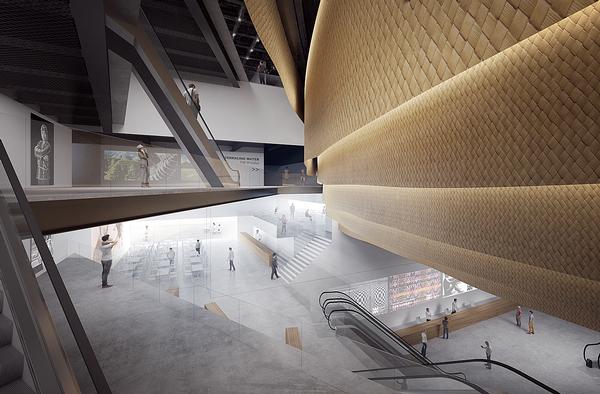
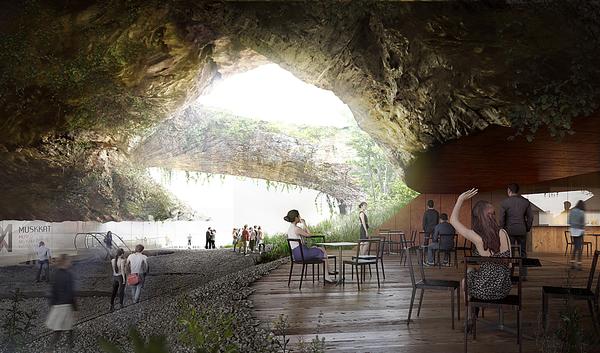
The Hans Christian Andersen Museum, Odense, Denmark
A peaceful garden and tall trees will surround cylindrical timber-clad volumes that house 6,000sq m (64,600sq ft) of new floor space, including an underground level. The complex, which will also include the city’s Tinderbox Cultural Centre for Children, is designed to create empathy, imagination and play while inspiring learning about the author’s famous fables.
As with the Manilla project, we have explored the beauty of nature. But the nature we pick up for each project is different. In Manilla it is very tropical. Here, I found beauty in the small hedged gardens of the city. Odense is not big. The scale of the space and the scale of the garden villages is very similar to a Japanese townscape. When I visited, I felt ‘ah this is very similar to my home.’ I wanted to take that emotion, and the shared vocabulary of these places, and translate that to a cultural building.
I love Hans Christian Andersen’s fairy tales. For kids, they’re very different from normal fairy tales which try to teach you something. Andersen tried to show the new world. I still remember many of them and I’ve always found them so exciting. Like some Japanese fairy tales they are surprising and sometimes scary, with a feeling of ‘wow’ at some of the endings!
My design tries to create some of that sense of involvement. We’ve contrasted between small spaces and big spaces, and straight spaces and spiralling spaces. That kind of contrast can create big surprises and big excitement for kids. That is the basis of the idea.
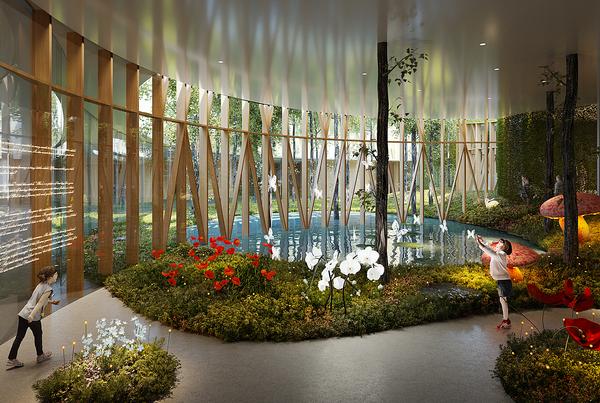
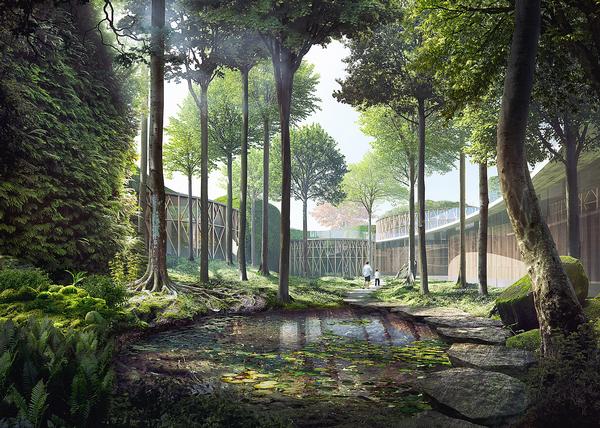
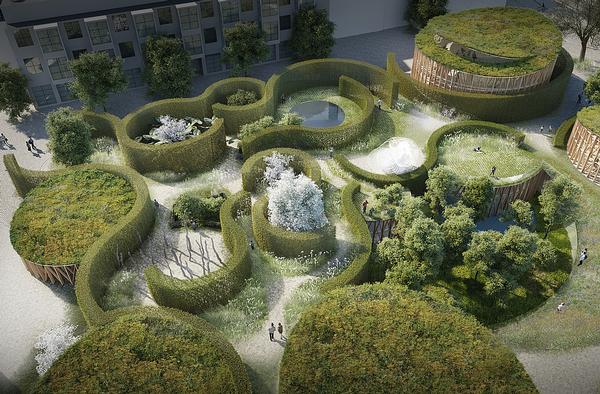
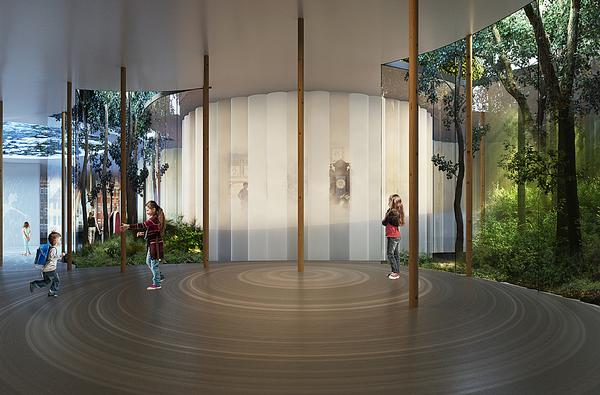
The Victoria and Albert Museum, Dundee, UK
The conceptual design was unveiled back in September 2010 for this landmark museum project on the banks of River Tay in Dundee’s Craig Harbour. Construction at the site began in March 2015 and the sculptural main building is expected to be completed by the end of 2017. When finished, the building will feature layers of prefabricated concrete beams and reconstituted stone cladding. It will chiefly house exhibition and gallery spaces for the V&A’s mammoth collection of art and cultural artefacts.
Dundee is not like Edinburgh and not like Glasgow. As a location it is very interesting. The river is beautiful, the bridge is beautiful. But before our project, the city and its beautiful nature were totally separated. The aim of our building is to combine nature and the city centre so we can achieve the kind of connection that allows the city to get energy from nature.
I was inspired by the ship Discovery, and by the cliffs in Scotland. The nature of the country is very tough. It’s not so mild. I wanted to translate that kind of natural beauty and toughness to the building.
The V&A people tried to make a very new concept; something different to what they had done before. It is very different from the V&A in London, which is mainly an example of architecture from the 19th century. Our new museum is a mixture of contemporary design and traditional and natural features. That combination can create a new type of chemistry and – I hope – a new type of design culture which will stimulate architecture and design in Scotland.
